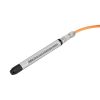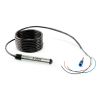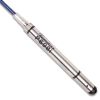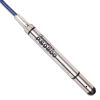Global Water WL400 Vented Water Level Sensor
Features
- Monitor levels in groundwater wells, rivers, streams, tanks, lift stations and open channels
- Dynamic temperature compensation system for high accuracy and reliability
- Vented pressure sensor for automatic barometric pressure compensation
- Free ground shipping
- Expedited repair and warranty service
- Lifetime technical support
- More
Each of the water level sensors consist of a solid state submersible pressure transducer encapsulated in a stainless steel 13/16 inch diameter housing. The water level sensor has a molded waterproof cable and a two-wire 4-20mA output for connection to a monitoring device. A 25 ft cable is standard, and optional cable lengths are available up to 500 ft.
The Water Level Sensor's submersible pressure transducer is fully encapsulated with marine-grade epoxy so that moisture can never leak in or work its way down the vent tube to cause drift or level sensor failure. The sensor uses a unique, highly flexible silicon diaphragm to interface between water and the sensing element. This silicon diaphragm protects the water level sensor's electronics from moisture and provides each sensor with exceptional linearity and very low hysteresis.
Water level ranges of 0-3, 0-15, 0-30, 0-60, 0-120, and 0-250 feet are available. The 0-3 ft low-level range is ideal for measuring shallow flows or small water level changes like those encountered in sewers, storm drains, weirs, and flumes. The 0-3 ft water monitoring sensor accurately measures small changes in water, even when the water's depth is only a few inches deep.
In The News
Long-Term Monitoring in the Chautauqua Lake Watershed
With a widely developed shoreline, Chautauqua Lake experiences influxes of non-point source pollution that have historically impacted the health of the lake. The Chautauqua Lake Association (CLA) has been monitoring the lake for over two decades, reporting on changes that have occurred over the years. A pair of local lake advocates, Jane and Doug Conroe, have lived on the lake for over 40 years and have played an important role in establishing monitoring programs and facilitating consistent data collection throughout the watershed. Doug has been involved with the Chautauqua Lake Association (CLA) since the pair moved to the area in 1980, and is currently serving as the Executive Director.
Read MoreNo Red Herrings: Data Driving the Largest Salt Marsh Restoration in the NE USA
The Herring River system encompasses around 1,000 acres in the Towns of Wellfleet and Truro, Massachusetts. In 1909, the Chequessett Neck Road dike was built at the river’s mouth, drastically limiting tidal flow. Today, it’s one of the most restricted estuaries in the northeastern United States. As a result, the area has suffered environmental decline, including poor water quality, hypoxia, lower pH, and salt marsh degradation. In 2023, the Town of Wellfleet received $14.7 million from NOAA’s Office of Habitat Conservation to fund the Herring River Restoration Project (HRRP). Francesco Peri, President and CEO at Charybdis Group LLC, uses a network of NexSens data loggers to monitor water level and water quality on the Herring River.
Read MoreCarbon and Nutrient Monitoring in the Great Lakes Using Satellite Observations
Carbon and nutrients are the foundation of lake food webs and play an important role in the chemical and physical processes that shape aquatic ecosystems and various lake dynamics. Studying these cornerstones can help improve understanding of other lake conditions like harmful algal blooms, hypoxia, and phytoplankton community composition. The way in which these characteristics are monitored varies, though many rely on a proxy approach wherein parameters are extrapolated from the measurement of a different parameter. An assistant professor at Cleveland State University, Brice Grunert, is working to improve current strategies and take a satellite approach to monitoring the Great Lakes.
Read More























































